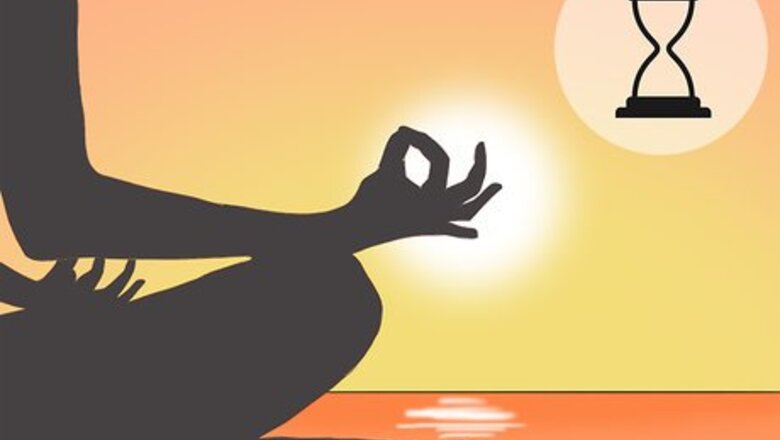
views
Organizing the Meditation Space
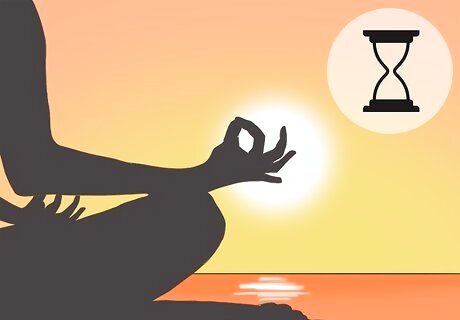
Choose a convenient time. Select a time during the day that you can routinely practice yoga without distraction or interruption. Make an attempt to practice yoga around the same time every day. As with any exercise, practicing yoga in the morning will keep your energy levels high throughout the day. Try not to make excuses to skip your exercise. You only need to do practice yoga 15-20 minutes a day and, therefore, you can do it in the morning before work, during lunch, or when you return home from work.
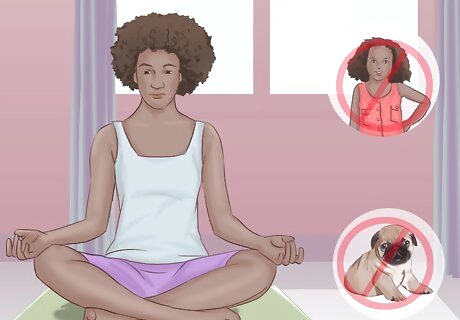
Select a comfortable place. Tranquil settings are best and can be inside or outside; just try to avoid interaction with people, pets, or objects. Wherever peace and quiet exists, however, is suitable enough. Make sure your mediation space is clean, ventilated, and enough space to roll out your yoga mat. Keep the temperature moderate and comfortable. Consider lighting aromatherapy candles to further relax your mind and body.

Wear appropriate clothing. Keep your yoga clothing as simple as possible. Because yoga is a stretching exercise, wear loose, comfortable clothing that gives your body the freedom to stretch and bend. Avoid wearing tight clothing that restricts movement. Take off jewelry and accessories, as they will become a nuisance during exercise. Other equipment, such as mats, balls, and other props can usually be bought at local sporting goods stores, online, or at yoga retail stores.
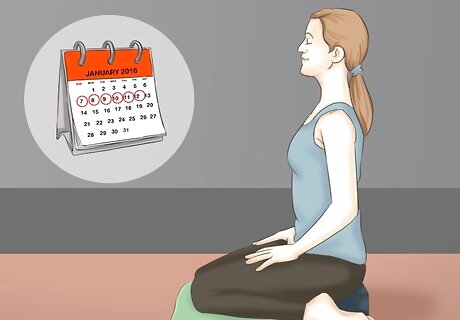
Be consistent. Make yoga practice a part of your daily schedule and lifestyle. Consistency will lead to greater results over time. Otherwise, it will be difficult to achieve the full lotus position. Keeping a consistent routine is important to maintaining a healthy lifestyle.
Preparing Your Body
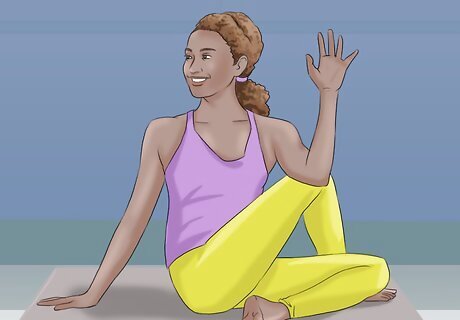
Prepare your hips. The lotus position requires flexibility. In this case, there are several less demanding yoga positions – the bound angle, hero pose, Half Lord of the Fishes pose – you can practice before trying the full lotus position. Sit cross-legged with your knees close to the ground to warm-up your lower body. Try moving your legs so that your knees are bent while your feet touch together, then pull your feet towards you while you bring your knees up and down for two minutes. Do a couple of cat stretches: get on your hands and knees with your hands at shoulder width apart. Arch your back (like a cat) and hold while taking deep breathes for two or three minutes. Do a few minutes of the baby pose: sit back on your knees with the top of your feet flat on the ground. Spread your knees apart and lay down so that your head is resting on the ground. Place your hands either straight above your head with palms facing down, or straight, next to your feet with palms facing up.
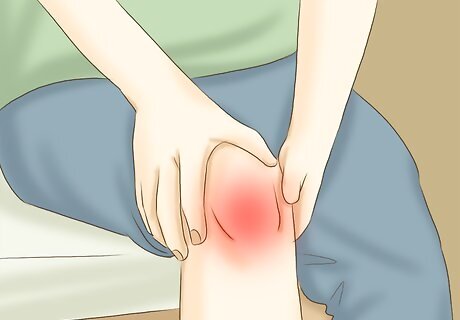
Avoid injury. If you already have an injured knee, ankle, hip, or any other chronic injury to the lower body it is best to probably avoid the lotus pose. This pose has a high risk of injury because of the demanding flexibility requirements. If you are a beginner, it is not a good idea to try this position on your own. Get a personal trainer or attend a class until you have mastered it. If you lack flexibility, try an easier pose like the half lotus or easy pose until you become more limber. Warming up is essential or risk straining your muscles. Always do a few body stretches to bring flexibility before moving into complicated yoga positions. Always respect your body and understand your limitations. Try to avoid moving too fast into a position or going beyond what your body can handle. This will only result in pain.
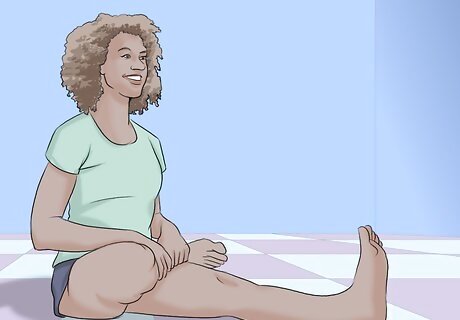
Start with the half lotus. The half lotus is a good start to mastering the full lotus pose. The half lotus pose is considered an intermediate yoga exercise. Start by sitting on the floor with head and spine erect with your shoulders back and your chest forward. Your legs should be straight out in front of you. With both hands, carefully bend your right leg at the knee and lift the right foot up and place it on your left thigh. Keep the bottom of your foot facing up while the other leg remains straight. Keep your balance as you follow the same procedure for your other leg but place your left leg under your right leg. The bottom of your left foot should be under your right thigh. Breathe deeply. Then, bring your arms to rest on your knees with palms facing up. Touch your thumb to the index finger to form the letter “o” while keeping the remaining three fingers straight. Try to keep your forearms straight. While in this position, try to let your entire body relax for at least one or two minutes if you can tolerate it. Finally, switch legs and do it again.
Performing the Full Lotus Position
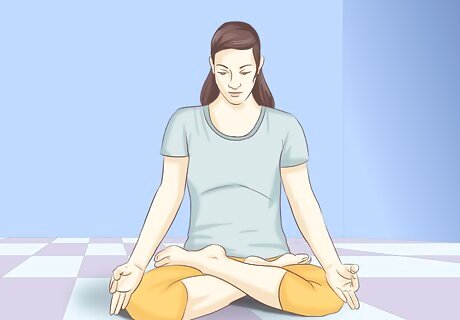
Execute the Lotus Pose. Depending on your age and ability, consult with a doctor to address any medical concerns before performing high-level, difficult yoga poses. The lotus pose is considered an advanced pose so make sure you stay within your own range of limits and abilities. Sitting on the floor with your legs extended out, keep your spine straight with your arms resting at your side. Bend your right knee towards your chest and begin to rotate it outward from the hip so that the bottom of your right foot faces upwards. The top of your foot should rest where your hip bends. Now, bend your left knee so that you can cross your left ankle over the top of your right shin. The bottom of your left foot should also face towards the sky. The top of your foot and ankle should rest where your hip bends. Bring your knees together as closely as possible. Push your midsection toward the floor and sit up straight. Press the outer edges of your feet down onto your thighs, lifting the outer ankles. This will ease pressure between your shins. Rest your hands on your knees with your palms facing up. Bring your hands into Gyan Mudra (Wisdom Seal) by joining the index finger and thumb on each hand. Extend the other fingers, but keep them together. This will calm you while you pause for a few meditating breaths. Once you are ready to finish, release the full lotus pose very carefully and slowly by gently extending both legs along the floor. As you maneuver out of the lotus position, pause at each step for a few minutes to meditate.
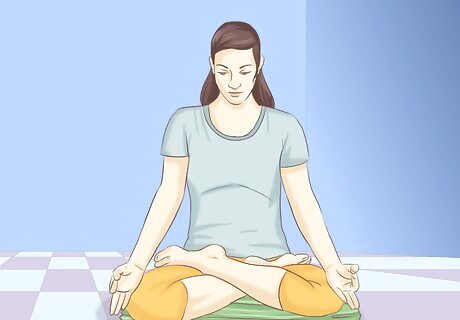
Consider modifications. If the full lotus pose causes you discomfort or you are just new to this then think about modifications that are still effective but safer until you become a master. A blanket is a good substitute between body parts and the floor. Fold a firm blanket and place it under each knee until you gain greater flexibility. If you find that even the half lotus difficult to hold for long periods of meditation, try the easy pose, or Sukhasana, first. On the other hand, for a greater challenge that requires additional strength try the scale pose, or Tolasana, by pressing your palms into the floor alongside your hips. Lift your buttocks and legs off the floor and allow your body to swing slightly. The bound lotus pose, or Baddha Padmasana, provides a deep stretch to the upper body which requires great flexibility. From the full expression of lotus pose, reach both arms behind your back, clasping your toes with your fingers. To deepen the stretch even further, fold forward. Other poses such as the headstand (Sirsasana), Fish Pose (Matsyasana), and Shoulderstand (Salamba Sarvangasana) can be done with your legs while in the lotus pose.
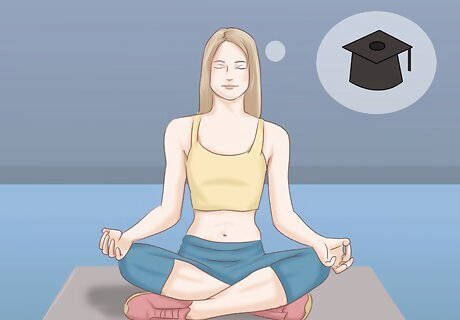
Staying aware of the present moment. If you are serious about yoga, the lotus pose will most likely be one of your main goals to achieve. It will take time to achieve this perfection, but remember that the goal is not to achieve the full expression of the lotus pose. Instead, the goal of yoga is staying aware of the present moment. Yoga is a patient practice and you must accept your boundaries as you progress.




















Comments
0 comment